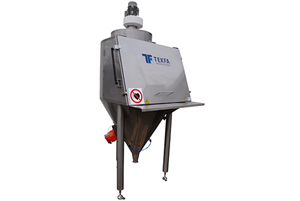Functional principles:
The operator places the bag on the conveyor, which transports the bag up to the machine. At the end of the conveyor, a sensor signals when the bag is in front of the machine. The entry gate opens, and the bag moves inside. Inside the machine, the bag is transported to a claw/hand with a built-in vacuum lift. The claw grips the bag and tilts 90°, holding the bag in a vertical position. While the bag is in this position, it is cut open at the bottom by three rotating knives. The knives cut the bag on each side and across the bottom. This allows the product to fall into the hopper while the bag remains intact in one piece. Once the bag is emptied, the claw tilts another 90°, where a piston pushes the emptied bag into the bag compactor. The claw then rotates back and is ready to grab the next bag.
Depending on the product being discharged (dust generation) and the desired speed, it can be determined when the next bag is fed in. Additionally, a dust extraction system can be connected to ensure airflow away from the gate, allowing the gate to be opened while a bag is being emptied (the point of maximum dust generation).
The machine has built-in CIP (Clean-In-Place). Since the windows are made of reinforced glass, it can be cleaned with hot water and most chemicals (alkali and acid). The unit is designed so that all points are covered and there is drainage for the CIP fluid. After CIP, the machine can be ventilated. The machine can be connected to a central dust extraction system.
Machine Control Cabinet: The machine is supplied with a control panel where the operator can select settings.
The bag emptier is suitable for food, pharmaceutical, and/or toxic products.



